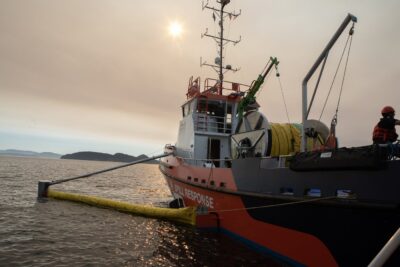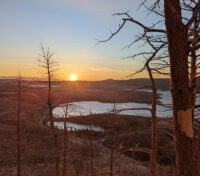Western Canada Marine Response Corporation exercised off Vancouver Island last month
By Canadian Press on October 5, 2025.

VICTORIA — Engineer Jashan Bains is the first to spot a black dorsal fin cutting through the water.
“Whale, one o’clock,” he says.
It’s a September morning on board the Hecate Sentinel, a 20-metre long skimming vessel, one of eight ships the Western Canada Marine Response Corp. maintains in Sidney, B.C., and one of eight bases along the B.C. coast.
Captain Dylan Adams, safety co-ordinator Lauren Walker and the rest of the bridge crew turned to see a second, then a third fin appear. They belong to a trio of killer whales.
“We don’t see orcas that often,” Adams says, glancing up from the instruments. “I would say it is more of a rare occurrence. It’s because they are so fast, they don’t spend a lot of time on the surface.”
For Adams and the rest of crew, the unexpected encounter is also reminder of the ecosystem they are tasked to protect.
On this day, Hecate Sentinel is on its way to join other vessels from Sidney, as well as from Beecher Bay west of Victoria and Nanaimo for a daylong exercise to contain an imaginary oil spill.
The practice is all the more important as more ships leave Vancouver’s Burrard Inlet after the expansion of the Trans Mountain oil pipeline and talk from Alberta Premier Danielle Smith about pushing for a pipeline across British Columbia’s north.
Five vessels, including Canada’s largest oil response ship, the nearly 75-metre-long K.J. Gardner, are out on the waters between Moresby and Pender islands.
It simulates among other elements the scooping up of oil by the Hecate Sentinel and its transfer to the Gardner.
The crew on the Hecate Sentinel unfurls self-inflating, yellow booms on either side of the ship, with the booms attached to beams hanging 90 degrees off the ship.
The booms funnel what would be contaminated water into the boat, where scrubbers separate the oil into a storage tank, to be emptied into the larger tanks of the Gardner.
Its crew also deploys what looks like a large floating dinghy to capture oil, while smaller vessels circling the Gardner are putting out semicircular-shaped booms.
The vessels are gathering in the Turn Point Special Operating Area where Canadian and American waters meet.
The area is at the intersection of Strait of Juan de Fuca off Greater Victoria with the Strait of Georgia off Greater Vancouver.
It’s called Turn Point because ships must make a sharp, almost 90-degree-turn along the Canada-U.S. border as they leave or head toward the Port of Vancouver, Canada’s busiest port.
Rules established in 2002 by both the American and Canadian coast guards try to reduce the risk of accidents, but various reports have identified it as a high-collision area because of local tides and weather conditions.
That is where Western Canada Marine comes into play.
Founded in 1976 as an industry co-operative to clean up spills in Vancouver’s Burrard Inlet, its coverage area expanded to the entire west coast following the Exxon Valdez disaster in Alaska in 1989, where more than 41 million litres of crude were spilled.
The Trans-Mountain pipeline expansion triggered more growth for the marine agency, where its staff grew to 220 and its fleet nearly doubled to 90 vessels.
The Canada Shipping Act requires the group to be able to respond to oil spills up to 10,000 tonnes, and it has said during testimony to a federal committee in Ottawa that it has 2.6 times as much necessary equipment in place for such a spill.
Michael Lowry, the senior communications manager for the corporation, says the operation is designed for the “worst-case, large-scale spill” along the lines of an Exxon-Valdez situation. The largest marine spill in Canadian history happened in 1970 when the M/T Arrow spilled over 10,000 tonnes of oil off Nova Scotia.
“Fortunately, we don’t see many more of those anymore,” he says.
Reasons include improved tanker designs and navigation requirements, Lowry says. But if something happens they can be on scene within six hours, and clean up 20,000 tonnes of oil in days.
“Ten days is the model,” he says. “If the spill is bigger, then it takes longer. So, we can certainly handle bigger spills. It’s just a time factor.”
Lowry says the group responds to an average of 20 spills per year.
“The majority of those are much smaller incidents, maybe a pleasure craft or a fishing vessel,” Lowry says.
The last “significant” black-oil spill where it responded was in 2023 in Nanaimo Harbour.
“But we are built for the worst-case spill,” he says.
The operation is funded by fees from shipping and oil-handling facilities on the polluter-pays principle, with a total of 2,300 organizations contributing to it. Any vessel more than 400 tonnes and any-oil transporting vessel over 150 tonnes must be part of the Western Canada Marine Response Corp.
As the only Transport-Canada certified spill response organization on the Canada’s West Coast, it operates around the clock with bases up down and the coast, including Prince Rupert, Lowry says
He says most of their vessels are centred around the southern shipping lanes, as most ship traffic comes from the Port of Vancouver.
That port has been getting busier. Figures from David Huntley, professor emeritus at Simon Fraser University’s physics department, have shown a 10-fold-increase in tanker traffic since the completion of the Trans-Mountain pipeline expansion in the summer of 2024.
Both B.C. and the federal government are also discussing measures to dredge Burrard Inlet as part of an idea to accelerate the flow of expansion through the current Trans-Mountain pipeline, with supporters saying that the dredging would actually reduce the number of tankers, because they could carry more oil.
Critics, meanwhile, have questioned the economics and environmental impacts of this proposal.
Lowry says his organization does not get involved in that discussion. He says the group is like the “fire department,” which does not comment on whether more condominiums should be built.
“We need to be ready if they do come into play,” Lowry says. “So, our job is to be ready for the risk that exists on the coast and be able to mitigate it to the best of our abilities.”
This report by The Canadian Press was first published Oct. 5, 2025.
Wolfgang Depner, The Canadian Press
-41




